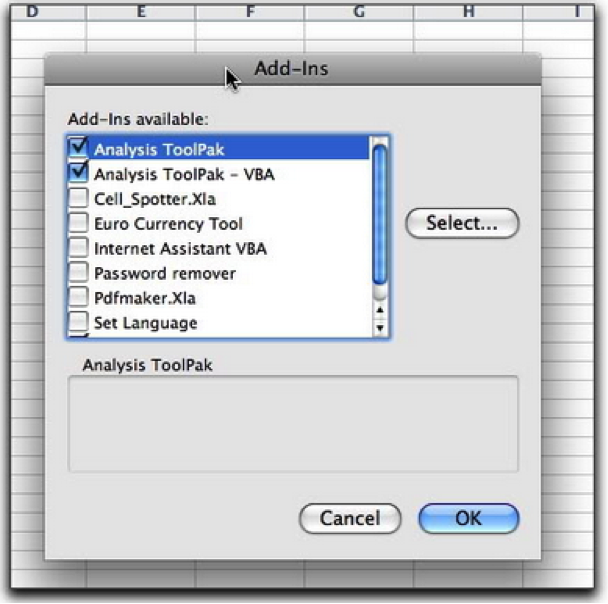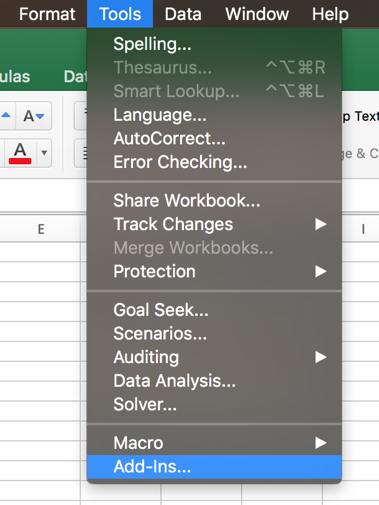How To Add The Data Analysis Tool Pack For Excel For Mac
Posted : admin On 10.04.2020You can move beyond the visual regression analysis that the scatter plot technique provides. You can use Excel’s Regression tool provided by the Data Analysis add-in. For example, say that you used the scatter plotting technique, to begin looking at a simple data set. You can then create a scatterplot in excel. And, after that initial examination, suppose that you want to look more closely at the data by using full blown, take-no-prisoners, regression.
Does mpeg1/mpeg2. Mjpeg tool for mac.
The Analysis ToolPak is a Microsoft Office Excel add-in program that is available when you install Microsoft Office or Excel. To use it in Excel, however, you need to load it first. Click the Microsoft Office Button, and then click Excel Options. Click Add-Ins, and then in the Manage box, select Excel Add-ins. Once Analysis ToolPak is loaded, you will see a Data Analysis item on the Data ribbon. In fact, if you have also loaded the Solver add-in, the Data Analysis button is right below the Solver button, as shown in Figure 2. Figure 2 Data Ribbon When you click the Data Analysis button, you see the list of tools available, some of which appear in Figure 3. In the Add-Ins box, check the Analysis ToolPak check box, and then click OK. If Analysis ToolPak is not listed in the Add-Ins available box, click Browse to locate it. If you are prompted that the Analysis ToolPak is not currently installed on your computer, click Yes to install it. Where is Data Analysis Toolpak or Solver in Excel 2011 on Mac? Click Tools -> Select Add-Ins. The Data Analysis Toolpak was removed in Mac:Office for Mac 2008. However, you can download a free third-party tool that offers similar functionality: StatPlus:mac LE.
To perform regression analysis by using the Data Analysis add-in, do the following:
Tell Excel that you want to join the big leagues by clicking the Data Analysis command button on the Data tab.
When Excel displays the Data Analysis dialog box, select the Regression tool from the Analysis Tools list and then click OK.
Excel displays the Regression dialog box.
Identify your Y and X values.
Use the Input Y Range text box to identify the worksheet range holding your dependent variables. Then use the Input X Range text box to identify the worksheet range reference holding your independent variables.
Each of these input ranges must be a single column of values. For example, if you want to use the Regression tool to explore the effect of advertisements on sales, you enter $A$1:$A$11 into the Input X Range text box and $B$1:$B$11 into the Input Y Range text box. If your input ranges include a label, select the Labels check box.
(Optional) Set the constant to zero.
If the regression line should start at zero — in other words, if the dependent value should equal zero when the independent value equals zero — select the Constant Is Zero check box.
(Optional) Calculate a confidence level in your regression analysis.
To do this, select the Confidence Level check box and then (in the Confidence Level text box) enter the confidence level you want to use.
Select a location for the regression analysis results.
Use the Output Options radio buttons and text boxes to specify where Excel should place the results of the regression analysis. To place the regression results into a range in the existing worksheet, for example, select the Output Range radio button and then identify the range address in the Output Range text box. To place the regression results someplace else, select one of the other option radio buttons.
Identify what data you want returned.
Select from the Residuals check boxes to specify what residuals results you want returned as part of the regression analysis.
Similarly, select the Normal Probability Plots check box to add residuals and normal probability information to the regression analysis results.
Click OK.
Excel shows a portion of the regression analysis results including three, stacked visual plots of data from the regression analysis.
There is a range that supplies some basic regression statistics, including the R-square value, the standard error, and the number of observations. Below that information, the Regression tool supplies analysis of variance (or ANOVA) data, including information about the degrees of freedom, sum-of-squares value, mean square value, the f-value, and the significance of F.
Download links are directly from our mirrors or publisher's website, mac eraser torrent files or shared files from free file sharing and free upload services, including Rapidshare, MegaUpload, YouSendIt, Letitbit, DropSend, MediaMax, HellShare, HotFile, FileServe, LeapFile, MyOtherDrive or MediaFire, are not allowed! Your computer will be at risk getting infected with spyware, adware, viruses, worms, trojan horses, dialers, etc while you are searching and browsing these illegal sites which distribute a so called keygen, key generator, pirate key, serial number, warez full version or crack for mac eraser. Top 4 Download periodically updates software information of mac eraser full versions from the publishers, but some information may be slightly out-of-date. Eraser tool on mac for photos. Using warez version, crack, warez passwords, patches, serial numbers, registration codes, key generator, pirate key, keymaker or keygen for mac eraser license key is illegal. These infections might corrupt your computer installation or breach your privacy.
Beneath the ANOVA information, the Regression tool supplies information about the regression line calculated from the data, including the coefficient, standard error, t-stat, and probability values for the intercept — as well as the same information for the independent variable, which is the number of ads. Excel also plots out some of the regression data using simple scatter charts.
Topics Map > OS and Desktop Applications > Applications > Productivity
Data Analysis Tool Pack For Mac
This document describes how to add the Data Analysis Pack to Microsoft Excel 2003, 2007, 2010 and 2013.
The Data Analysis pack is a powerful set of tools used to figure out the variance, correlation and covariance of data as well as other features. Although the Data Analysis pack is a standard feature that comes with Excel, it may not be loaded into Excel. If it is already added, Data Analysis will be listed under the Tools menu in Micosoft Excel 2003 or under the Data tab in Excel 2007 and 2010.

If it is not listed, you will have to add it.
Excel 2007, 2010, and 2013
How To Add The Data Analysis Toolpak For Excel For Mac Free

The menu path will depend on which version of Excel you are using:
- In Excel 2007, go to the Microsoft Office button ->Excel Options.
- In Excel 2010 or 2013, go to File ->Options.
- Select Add-Ins and confirm that the Analysis ToolPak appears in the list of 'Inactive Application Add-ins.' If it is inactive, click on Go.. next to the Manage: Excel Add-ins drop-down menu.
- Place checkmarks next to Analysis ToolPak and Analysis ToolPak - VBA and click OK.
- Go to Tools ->Add-Ins...
- Place checkmarks next to Analysis ToolPak and Analysis ToolPak - VBA and click OK.
Excel 2003
Excel should install the Data Analysis options from there. It may, however, require the original Microsoft Excel or Office CD to complete installation.
| Keywords: | microsoft excel 2003 2007 2010 2013 data analysis pack toolpakSuggest keywords | Doc ID: | 1232 |
|---|---|---|---|
| Owner: | Leah S. | Group: | DoIT Help Desk |
| Created: | 2002-01-14 19:00 CDT | Updated: | 2017-12-11 17:47 CDT |
| Sites: | DoIT Help Desk, Southern Illinois University Edwardsville | ||
| Feedback: | 17258CommentSuggest a new document | ||